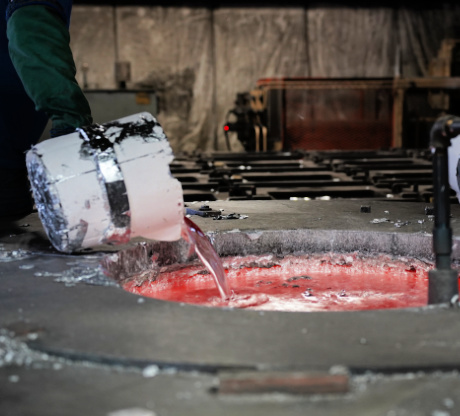The 7-Second Trick For Aluminum Castings Company
Table of ContentsSee This Report on Aluminum Castings CompanyThe Greatest Guide To Aluminum Castings CompanyAluminum Castings Company Things To Know Before You BuyNot known Details About Aluminum Castings Company Some Known Details About Aluminum Castings Company The Basic Principles Of Aluminum Castings Company The Greatest Guide To Aluminum Castings CompanyThe Best Strategy To Use For Aluminum Castings Company
There are two main sorts of die spreading used in the light weight aluminum spreading industry: warm chamber pass away spreading and cool chamber pass away spreading. The primary distinction between these approaches is just how the molten steel is delivered to the mold. In hot chamber pass away spreading, commonly utilized for reduced melting factor steels, the melting pot is directly connected to the equipment, and a bettor forces the product via a gooseneck right into the die dental caries.The smart Trick of Aluminum Castings Company That Nobody is Discussing
In these methods, the mold and mildew is intentionally damaged or escaped in order to draw out the completed light weight aluminum casting. Common processes under the category of expendable mold spreading include (investment spreading),,, and investment casting. When producing personalized light weight aluminum parts using expendable mold and mildews, makers pour liquified light weight aluminum or aluminum alloys right into the mold and mildew, which is after that busted apart to launch the solidified metal part.
The is one of the oldest and most widely used types of aluminum spreading. It involves compacting specialized factory sand, frequently enhanced with clay or resin, around an exactly crafted reusable pattern that figures out the shape and interior information of the ended up aluminum product. The pattern system incorporates risers and vents to handle the circulation of molten steel and to avoid casting issues such as shrinking porosity.
More About Aluminum Castings Company

This mold is then preheated before the pouring of molten light weight aluminum or light weight aluminum alloy. As the steel loads the shell, it captures the intricate details and great surface area coating of the mold. When cooled, the ceramic is mechanically or chemically damaged away, permitting the elimination and splitting up of private actors parts.
Aluminum Castings Company Things To Know Before You Get This
Irreversible mold and mildew casting uses multiple-use steel mold and mildews and is perfect for automation with consistent top quality and much less waste. Expendable mold casting makes use of single-use mold and mildews, like sand or foam, providing design adaptability and lower tooling prices for prototypes or brief runs. Die spreading is best for creating high volumes of aluminum components that require tight resistances, fine information, and smooth surfaces.
The Toshiba Equipment DC-J Series consists of die casting equipments appropriate for light weight aluminum. Known for their robust building and construction and high shot performance, these devices ensure efficient and precise spreading (Metal Foundry).

While light weight aluminum can be used in its pure type, it is usually alloyed with other steels to enhance its residential properties or the residential or commercial properties of the various other metals. These alloys supply boosted efficiency for different applications. Light weight aluminum alloys are classified right into 8 collection, phoned number from one to 8. The first number(s) of the number suggest the main alloying component combined with light weight aluminum.
The Single Strategy To Use For Aluminum Castings Company
This alloying enhances the stamina and firmness of aluminum yet lowers its ductility and deterioration resistance. The 2000 series alloys are challenging to weld but can be heat treated to boost their residential properties. The 3000 series alloys are mostly alloyed with manganese. This mix improves corrosion resistance while providing modest stamina.
The 4000 collection alloys are alloyed with silicon, which lowers the melting factor and improves fluidity. This makes it a prominent choice for spreading, as it is simple to develop in its liquified state.
All about Aluminum Castings Company
This series is classified as a high-strength alloy, particularly fit for sheet and plate applications as a result of its excellent weldability. Its resistance to deterioration from acids and alkalis makes it perfect for use in rough and aggressive atmospheres (Sand Mold). The 6000 series alloys are alloyed with both magnesium and silicon, supplying an equilibrium of stamina, mechanical homes, and rust resistance
Processing the 6000 series needs specialized and innovative equipment, which can be intricate and pricey. However, this series is known for its superb rust and oxidation resistance, as well as its convenience of covering, treatment, and workability. The 7000 collection light weight aluminum alloys are the toughest and most durable amongst light weight aluminum types, with strength comparable to about two-thirds of industrial-grade A3 steel.
How Aluminum Castings Company can Save You Time, Stress, and Money.
Zinc is the key alloying component in the 7000 series, boosting the firmness go now of the aluminum, even though zinc's solidity resembles that of aluminum on the Mohs range. The 8000 collection light weight aluminum alloys are primarily alloyed with tin, together with little amounts of copper and nickel (Aluminum Castings). While these alloys use reduced toughness contrasted to other collection, they master machinability and use resistance
Light weight aluminum cast heatsinks are electrically conductive, allowing them to be grounded properly. They are typically cast with incorporated features that lessen the demand for secondary operations, such as added machining or setting up, resulting in additional cost savings. Aluminum casting is often made use of to make brackets for both sturdy industrial tools and household home appliances.
Fascination About Aluminum Castings Company
The single-piece building of aluminum brackets improves their stamina and longevity, minimizing the likelihood of failure. If holes are required, they can be consisted of straight in the casting mold and mildew, minimizing the demand for post-production ending up (https://www.figma.com/design/wpm5TIDjRpCjfLBlGXe0Hj/Untitled?node-id=0-1&t=7oXKj2YeMK8TGHso-1). Producers have increasingly adopted aluminum casting for golf tools as a result of its resilience, stability, and convenience in shaping